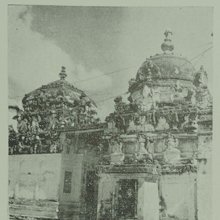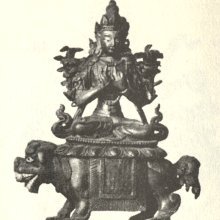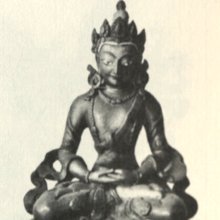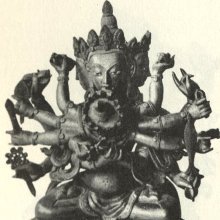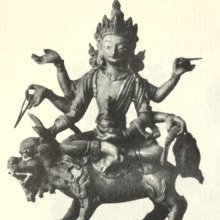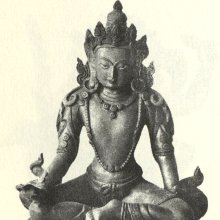Ishvara, Īśvara, Ishwara, Iśvara: 46 definitions
Introduction:
Ishvara means something in Buddhism, Pali, Hinduism, Sanskrit, Jainism, Prakrit, the history of ancient India, Marathi, Hindi, biology. If you want to know the exact meaning, history, etymology or English translation of this term then check out the descriptions on this page. Add your comment or reference to a book if you want to contribute to this summary article.
The Sanskrit terms Īśvara and Iśvara can be transliterated into English as Isvara or Ishvara, using the IAST transliteration scheme (?).
Alternative spellings of this word include Eswar.
Images (photo gallery)
(+55 more images available)
In Hinduism
Vaisheshika (school of philosophy)
Source: Wisdom Library: The Nyāya-Vaiśeṣika PhilosophyAccording to the Nyāya-Vaiśeṣika view Īśvara wishing to give some respite or rest to all living beings desires to bring about dissolution (saṃhāreccho bhavati). Simultaneously with it the adṛṣṭa force residing in all the souls and forming bodies, senses, and the gross elements, ceases to act (śakti-pratibandha).
At the time of creation, Īśvara wishes to create and this desire of Īśvara works in all the souls as adṛṣṭa. This one eternal desire of Īśvara under certain conditions of time (e.g. of pralaya) as accessory causes (sahakāri) helps the disintegration of atoms and at other times (e.g. that of creation) the constructive process of integration and unification of atoms for the world-creation.
Nyāya believes that Īśvara has fashioned this universe by his will out of the ever-existing atoms. For every effect (e.g. a jug) must have its cause. This world therefore being an effect must be preceded by a cause, and this cause is Īśvara. This cause we cannot see, because Īśvara has no visible body, not because he does not exist. This cause is Īśvara. He has infinite knowledge and is all merciful. At the beginning of creation He created the Vedas. He is like our father who is always engaged in doing us good.

Vaisheshika (वैशेषिक, vaiśeṣika) refers to a school of orthodox Hindu philosophy (astika), drawing its subject-matter from the Upanishads. Vaisheshika deals with subjects such as logic, epistemology, philosophy and expounds concepts similar to Buddhism in nature
Purana and Itihasa (epic history)
Source: archive.org: Puranic EncyclopediaĪśvara (ईश्वर).—Once Devī told Himavān who, according to the Hindu religion, God is, and how creation takes place from Īśvara (God). The famous discussion about Godhood, called Devīgītā is quoted hereunder.
"(1) ahamevāsa pūrvaṃ tu nānyad kiṃcit nagādhipa / tadātmarūpaṃ cit saṃvit parabrahmaikanāmakam. //" (Before the creation of the universe commenced, I alone was; there was nothing else. Then I was called Parabrahman, Citsvarūpī, Saṃvitsvarūpī and Ātmarūpī). (See full article at Story of Īśvara from the Puranic encyclopaedia by Vettam Mani)
Source: archive.org: Shiva Purana - English Translation1) Īśvara (ईश्वर) refers to a being of pure nature, as explained in the section of great dissolution (mahāpralaya), according to Śivapurāṇa 1.25.
Accordingly:—
“[...] the Being, having no form of its own, wished to create, in the course of its own sport, an auspicious form of its own endowed with all power, qualities and knowledge. A form that goes everywhere, that has all forms, that sees all, that is the cause of all, that should be respected by all, that is at the beginning of all, that bestows everything, and that sanctifies everything should be created (So it wished) and hence created that form of Īśvara of pure nature. The original Being without a second, with neither beginning nor end, that illuminates everything, that is in the form of Cit (pure knowledge), that which is termed Supreme Brahman, the all-pervasive and undecaying, vanished, The manifest form of the formless Being is Sadāśiva. Scholars of the ancient and succeeding ages have sung of it as Īśvara”.
2) Īśvara (ईश्वर) is used as an epithet for Śiva, according to the Śivapurāṇa 2.2.41.—Accordingly, as Viṣṇu and others eulogized Śiva:—“[...] obeisance to Vāma, Vāmarūpa, Vāmanetra, Aghora, the great lord and the Vikaṭa. Obeisance to Tatpuruṣa, to Nātha, the ancient Puruṣa, the bestower of the four aims of life, Vratin, and Parameṣṭhin. Obeisance to you, Īśāna, Īśvara, Brahman, of the form of Brahman, the Supreme Soul”.
Source: Cologne Digital Sanskrit Dictionaries: The Purana IndexĪśvara (ईश्वर).—Also maheśvara and śaṅkara; a Rudra: place of residence is Śivapura in front of Brahmaloka; Lord of Trinity;1 the adhidevatā for the planet Sūrya;2 the 26th tatva on one view;3 being a small atom is god of love for people; in him are ten characteristics—knowledge, vairāgya, aiśvarya, tapas, satya, patience, courage, quality of being seen, kinship to self and dominion; is māyā or illusory;4 the Lord of all world.5
- 1) Brahmāṇḍa-purāṇa III. 3. 71; IV. 39. 120; Matsya-purāṇa 171. 39.
- 2) Matsya-purāṇa 93. 13.
- 3) Matsya-purāṇa 3. 28.
- 4) Vāyu-purāṇa 101. 215, 219; Brahmāṇḍa-purāṇa IV. 2. 217.
- 5) Vāyu-purāṇa 4. 36 and 42.
Īśvara (ईश्वर) is a name mentioned in the Mahābhārata (cf. I.61.60) and represents one of the many proper names used for people and places. Note: The Mahābhārata (mentioning Īśvara) is a Sanskrit epic poem consisting of 100,000 ślokas (metrical verses) and is over 2000 years old.
Īśvara is also mentioned in the Mahābhārata (cf. I.60.3) and represents one of the many proper names used for people and places.
Source: Shodhganga: The saurapurana - a critical studyĪśvara (ईश्वर) is the deity to be worshipped in the month Āśvina for the Anaṅgatrayodaśī-Vrata, according to the 10th century Saurapurāṇa: one of the various Upapurāṇas depicting Śaivism.—Accordingly, the Anaṅgatrayodaśī-vrata is observed in honour of Śiva for acquiring virtue, great fortune, wealth and for destruction of sins [...] This vrata is to be performed for a year from Mārgaśīra.—In the month of Āśvina the tooth-brush is that of jambu-wood, the deity is Īśvara the food is taṇḍulodaka result accrued is eight times that of pauṇḍarika sacrifice.

The Purana (पुराण, purāṇas) refers to Sanskrit literature preserving ancient India’s vast cultural history, including historical legends, religious ceremonies, various arts and sciences. The eighteen mahapuranas total over 400,000 shlokas (metrical couplets) and date to at least several centuries BCE.
Shaivism (Shaiva philosophy)
Source: Wisdom Library: ŚaivismĪśvara (ईश्वर) is the Sanskrit name of a deity presiding over Mahāliṅgasthala, one of the sixty-eight places hosting a svāyambhuvaliṅga, which is one of the most sacred of liṅgas according to the Śaivāgamas. The list of sixty-eight svāyambhuvaliṅgas and presiding deities (e.g., Īśvara) is found in the commentary on the Jirṇoddhāra-daśaka by Nigamajñānadeva. The word liṅga refers to a symbol used in the worship of Śiva and is used thoughout Śaiva literature, such as the sacred Āgamas.
Source: SOAS University of London: Protective Rites in the Netra TantraĪśvara (ईश्वर) refers to the “(divine) Lord”, according to the Netratantra of Kṣemarāja: a Śaiva text from the 9th century in which Śiva (Bhairava) teaches Pārvatī topics such as metaphysics, cosmology, and soteriology.—Accordingly, [verse 2.22cd-28ab]—“[...] That is supreme strength, that is supreme amṛt. The highest of splendors is highest light of light. The divine Lord (īśvara—devam īśvaraṃ) is the supreme cause of all the world. The creator, supporter, and destroyer are not as strong as this. This receptacle of mantras is the word of all perfections and characteristics [...]”.

Shaiva (शैव, śaiva) or Shaivism (śaivism) represents a tradition of Hinduism worshiping Shiva as the supreme being. Closely related to Shaktism, Shaiva literature includes a range of scriptures, including Tantras, while the root of this tradition may be traced back to the ancient Vedas.
Shilpashastra (iconography)
Source: Archaeological Survey of India: Śaiva monuments at Paṭṭadakal (śilpa)Īśvara (ईश्वर).—The Vātulaśuddhākhyāgama gives a description of Īśvara who is in the centre of the Liṅga (found as a sculpture at the temple of Lokeśvara). He has four heads and eight hands. The right hands are adorned with attributes such as triśūla, paraśu, khaḍga and abhaya;in his left hands are pāśa, sarpa, ghaṇṭā and varada (paṭala 1, verses 64-66).

Shilpashastra (शिल्पशास्त्र, śilpaśāstra) represents the ancient Indian science (shastra) of creative arts (shilpa) such as sculpture, iconography and painting. Closely related to Vastushastra (architecture), they often share the same literature.
Jyotisha (astronomy and astrology)
Source: Wisdom Library: Brihat Samhita by VarahamihiraĪśvara (ईश्वर) refers to the eleventh of the sixty-year cycle of Jupiter, according to the Bṛhatsaṃhitā (chapter 8), an encyclopedic Sanskrit work written by Varāhamihira mainly focusing on the science of ancient Indian astronomy astronomy (Jyotiṣa).—Accordingly, “The five years of the third yuga sacred to Indra are known as—1. Īśvara, 2. Bahudhānya, 3. Pramāthin, 4. Vikrama and 5. Vṛṣa. In the first two years mankind will enjoy the happiness of Kṛtayuga. In the year Pramāthin they will feel miserable but in the years Vikrama and Vṛṣa they will again be happy”.
Source: The effect of Samvatsaras: SatvargasĪśvara (ईश्वर) refers to the eleventh saṃvatsara (“jovian year)” in Vedic astrology.—The native whose birth occurs in the ‘samvatsara’ of ‘ishvara’ gets angry very soon (that is, he is short tempered), is full of joy, has good qualities in him, is valorous, skilful and sagacious, skilled in arts and is courteous.
According with Jataka Parijata, the person born in the year ishvara (1997-1998 AD) will be prosperous, steady-minded, and a good judge of merit.

Jyotisha (ज्योतिष, jyotiṣa or jyotish) refers to ‘astronomy’ or “Vedic astrology” and represents the fifth of the six Vedangas (additional sciences to be studied along with the Vedas). Jyotisha concerns itself with the study and prediction of the movements of celestial bodies, in order to calculate the auspicious time for rituals and ceremonies.
Pancaratra (worship of Nārāyaṇa)
Source: Shodhganga: Iconographical representations of Śiva (pancaratra)Īśvara (ईश्वर) or Īśvarasaṃhitā is the name of a Vaiṣṇava Āgama scripture, classified as a sāttvika type of the Muniprokta group of Pāñcarātra Āgamas. The vaiṣṇavāgamas represent one of the three classes of āgamas (traditionally communicated wisdom).—Texts of the Pāñcara Āgamas are divided in to two sects. It is believed that Lord Vāsudeva revealed the first group of texts which are called Divya and the next group is called Muniprokta which are further divided in to three viz. a. Sāttvika (e.g., Īśvara-saṃhitā). b. Rājasa. c. Tāmasa.
Source: University of Vienna: Sudarśana's Worship at the Royal Court According to the AhirbudhnyasaṃhitāĪśvara (ईश्वर) refers to a “governor” (of a province or district), according to the Ahirbudhnyasaṃhitā, belonging to the Pāñcarātra tradition which deals with theology, rituals, iconography, narrative mythology and others.—Accordingly, “A ruler who is a Universal Sovereign is entitled to the first, a Provincial Governor (maṇḍala-īśvara) to the second and a District Governor (viṣaya-īśvara) to the third [level of] Creative Energy. [To the same are entitled] a chief minister or a twice-born, provided he is in charge of the protection of many people. No single man is entitled to [deploy] Her for [just] another man”.

Pancaratra (पाञ्चरात्र, pāñcarātra) represents a tradition of Hinduism where Narayana is revered and worshipped. Closeley related to Vaishnavism, the Pancaratra literature includes various Agamas and tantras incorporating many Vaishnava philosophies.
Vaishnavism (Vaishava dharma)
Source: Pure Bhakti: Bhagavad-gita (4th edition)Īśvara (ईश्वर) refers to “supreme Controller, Bhagavān. Also a name for the Supersoul (15.15)”. (cf. Glossary page from Śrīmad-Bhagavad-Gītā).
Source: Pure Bhakti: Arcana-dipika - 3rd EditionĪśvara (ईश्वर) is the eleventh of sixty years (saṃvatsara) in the Vedic lunar calendar according to the Arcana-dīpikā by Vāmana Mahārāja (cf. Appendix).—Accordingl, There are sixty different names for each year in the Vedic lunar calendar, which begins on the new moon day (Amāvasyā) after the appearance day of Śrī Caitanya Mahāprabhu (Gaura-pūrṇimā), in February or March. The Vedic year [viz., Īśvara], therefore, does not correspond exactly with the Christian solar calendar year.
Source: Pure Bhakti: Brhad BhagavatamrtamIśvara (इश्वर) refers to:—Supreme Lord. (cf. Glossary page from Śrī Bṛhad-bhāgavatāmṛta).

Vaishnava (वैष्णव, vaiṣṇava) or vaishnavism (vaiṣṇavism) represents a tradition of Hinduism worshipping Vishnu as the supreme Lord. Similar to the Shaktism and Shaivism traditions, Vaishnavism also developed as an individual movement, famous for its exposition of the dashavatara (‘ten avatars of Vishnu’).
Vedanta (school of philosophy)
Source: Shodhganga: Siva Gita A Critical StudyĪśvara (ईश्वर) or Īśvaragītā refers to one of the sixty-four Gītās commonly referred to in Hindu scriptures.—Gītā is the name given to certain sacred writings in verse (often in the form of a dialogue) which are devoted to the exposition of particular religious and theosophical doctrines. Most of these Gītās [i.e., Īśvara-gītā] originate from the Mahābhārata or the various Purāṇas.

Vedanta (वेदान्त, vedānta) refers to a school of orthodox Hindu philosophy (astika), drawing its subject-matter from the Upanishads. There are a number of sub-schools of Vedanta, however all of them expound on the basic teaching of the ultimate reality (brahman) and liberation (moksha) of the individual soul (atman).
Shaktism (Shakta philosophy)
Source: Google Books: Manthanabhairavatantram1) Īśvara (ईश्वर) and Vibhūti refers to the pair of God and Goddess appearing in the seventh Kalpa (aeon), according to the Kularatnoddyota.—Chapter nine of the Kularatnoddyota opens with the goddess asking how the Kula tradition (kulāmnāya) will be worshipped along with its mantras and Vidyās and who will bring it down (avatāraka) into the world in the various cosmic aeons (kalpa). After explaining that it is brought down into the world by incarnations or aspects of both the god and the goddess (aṃśamātra), the god goes on to list the names of these aspects—a goddess and her consort [i.e., Vibhūti—Īśvara]—in nineteen aeons (kalpa), many of which we recognize from the earlier version in the Tantrasadbhāva.—(cf. Jayadrathayāmala-tantra of the Kāpālikas).
2) Īśvara (ईश्वर) refers to one of the twenty-one spheres of the rūpa state, according to Tantric texts such as the Kubjikāmata-tantra, the earliest popular and most authoritative Tantra of the Kubjikā cult.—Chapter nineteen of the Kubjikāmatatantra begins with an exposition of the state called Form (rūpa). This is manifest in twenty-one spheres (cakra) [i.e., Īśvara—between the eyebrows] of ‘millions’ (koṭi) of energies arranged along the axis of the head starting with the throat, up through the eyebrows and beyond. [...]

Shakta (शाक्त, śākta) or Shaktism (śāktism) represents a tradition of Hinduism where the Goddess (Devi) is revered and worshipped. Shakta literature includes a range of scriptures, including various Agamas and Tantras, although its roots may be traced back to the Vedas.
Ganitashastra (Mathematics and Algebra)
Source: archive.org: Hindu MathematicsĪśvara (ईश्वर) represents the number 11 (eleven) in the “word-numeral system” (bhūtasaṃkhyā), which was used in Sanskrit texts dealing with astronomy, mathematics, metrics, as well as in the dates of inscriptions and manuscripts in ancient Indian literature.—A system of expressing numbers by means of words arranged as in the place-value notation was developed and perfected in India in the early centuries of the Christian era. In this system the numerals [e.g., 11—īśvara] are expressed by names of things, beings or concepts, which, naturally or in accordance with the teaching of the Śāstras, connote numbers.

Ganitashastra (शिल्पशास्त्र, gaṇitaśāstra) refers to the ancient Indian science of mathematics, algebra, number theory, arithmetic, etc. Closely allied with astronomy, both were commonly taught and studied in universities, even since the 1st millennium BCE. Ganita-shastra also includes ritualistic math-books such as the Shulba-sutras.
General definition (in Hinduism)
Source: WikiPedia: Hinduism1: Ishvara (ईश्वर): A Hindu philosophical concept of God referring to the Supreme Being which is the lord and the ruler of everything. Hinduism uses the term Ishvara exclusively to refer to the Supreme God in a monotheistic sense.
2: Ishvara (Īśvara in IAST) is a philosophical concept in Hinduism, meaning controller or god in a theistic school of thought, or as an Ishta-deva in monistic thought.
Source: Academia.edu: The description of Śivapura in the early Vāyu- and SkandapurāṇaAccording to the Vāyu-Purāṇa (2.39.215–216) Īśvara can (only) be conceived by the learned, because he is an infinitesimal atom. Ten qualities –
- Jñāna,
- Vairāgya,
- Aiśvarya,
- Tapas,
- Satya,
- Kṣamā,
- Dhṛti,
- Draṣṭṛtva,
- Ātmasambandha and
- Adhiṣṭhātṛtva
– are said to reside continuously in him. The Skanda-Purāṇa (183.6cd–8) identifies this Īśvara who is an infinitesimal atom with Vigraheśvara. This seems to reflect a significant theological development. The same figure is mentioned again in Skanda-Purāṇa 183.19a (sthānaṃ vigraheśasya), but hedoes not play a role in the Vāyupurāṇa; in fact he is known mainly from Śaiva Tantric literature, where he is located in various spots of the Śaiva universe, butnever in Śivaloka. The name Vigraheśvara indicates that he is intended to be identical with thesakalaform of Śiva, mentioned at the start of this passage (Skanda-Purāṇa 183.2b).
In both sources the Lord is identified with the (inner) fire of Yoga and issaid to assume physical form (Vāyu-Purāṇa 2.39.217 ≈ Skanda-Purāṇa 183.9). His magical abode (māyāmaya sthāna / māyādhāman) is the eighth world (beyond the seven worlds of Mahat etc.) and is beyond misfortune (aupasargika).
Source: Red Zambala: On the Salvific Activities of GodThe Five manifestations of God (Īśvara) according to the Pāñcharātra Śāstras are:
- Para — the transcendental Super Absolute form from which all the others emanate.
- Vyūha — the four hypostatic emanations Vāsudeva, Saṅkarṣaṇa, Pradyumna and Aniruddha; which have cosmic function of projection, preservation and transformation.
- Vibhava — Incarnations which appear from time to time to rectify and restore harmony and balance to the universe, such as Rāma, Krishna etc.
- Antaryāmin — the form abiding within all living beings.
- Arcā-avatāra — the appearance out of condescension and love, in icons that are made and consecrated according to the Pāñcharātra rituals.
In Buddhism
Mahayana (major branch of Buddhism)
Source: Wisdom Library: Mahayana BuddhismĪśvara (ईश्वर) from Sumukha is the name of a youth included in the list of spiritual friends of Sudhana: the son of a merchant from Sukhākara who received a prophecy from Mañjuśrī, according to the Avataṃsaka-sūtra. Accordingly, Sudhana devoted himself to 110 spiritual friends in a great building adorned with the ornaments of Vairocana. These spiritual friends included monks, bodhisattvas, ṛṣis, brāhmaṇas, girls, kings, youths (e.g., Īśvara), goddesses, householders, etc. From these beings, Sudhana took the vows without the need for any formal basis.

Mahayana (महायान, mahāyāna) is a major branch of Buddhism focusing on the path of a Bodhisattva (spiritual aspirants/ enlightened beings). Extant literature is vast and primarely composed in the Sanskrit language. There are many sūtras of which some of the earliest are the various Prajñāpāramitā sūtras.
Tibetan Buddhism (Vajrayana or tantric Buddhism)
Source: Wisdom Library: Tibetan BuddhismĪśvara (ईश्वर) is the name of Vidyārāja (i.e., “wisdom king”) mentioned as attending the teachings in the 6th century Mañjuśrīmūlakalpa: one of the largest Kriyā Tantras devoted to Mañjuśrī (the Bodhisattva of wisdom) representing an encyclopedia of knowledge primarily concerned with ritualistic elements in Buddhism. The teachings in this text originate from Mañjuśrī and were taught to and by Buddha Śākyamuni in the presence of a large audience (including Īśvara).

Tibetan Buddhism includes schools such as Nyingma, Kadampa, Kagyu and Gelug. Their primary canon of literature is divided in two broad categories: The Kangyur, which consists of Buddha’s words, and the Tengyur, which includes commentaries from various sources. Esotericism and tantra techniques (vajrayāna) are collected indepently.
In Jainism
Jain philosophy
Source: International Journal of Jaina Studies: Haribhadra Sūri on Nyāya and SāṃkhyaĪśvara (ईश्वर) or Īśvaravāda refers to “(the doctrine of) God”.—The Śāstravārtāsamuccaya by Haribhadra Sūri’s is not a compendium of philosophical systems (darśana) but a comprehensive account (samuccaya) of doctrinal (śāstra) expositions (vārtā/vārttā) or simply doctrines (vāda). The Śāstravārtāsamuccaya (also, Śāstravārttāsamuccaya) is subdivided into stabakas, chapters or sections, for example: Īśvara-vāda—on the doctrine of God of the Nyāya-Vaiśeṣika.
-
General definition (in Jainism)
Source: archive.org: The Jaina Iconography1) Īśvara (ईश्वर) or Īśvarayakṣa is the name of the Yakṣa accompanying Abhinandananātha: the fourth of twenty-four Tīrthaṃkaras or Jinas, commonly depicted in Jaina iconography.—The tree connected with [Abhinandananātha’s] Kevala knowledge is Piyāla (Veśāli tree according to other texts). The Yakṣa believed to have been appointed by Indra, as in all cases, to serve him is named Īśvara and the Yakṣiṇī’s name is Kālī. The particular pose in which he is to appear in sculpture is called Khaḍgāsana i.e., standing posture.
2) Īśvara (ईश्वर) or Yakṣeta is also the Yakṣa accompanying Śreyāṃśanātha: the eleventh of twenty-four Tīrthaṃkaras.—The Jaina texts concur in giving Śreyāṃśanātha the symbol of a rhinoceros. The Yakṣa and the Yakṣiṇī to serve him as guards of honour, have been named as Yakṣeta and Mānavī (Digambara: Īśvara and Gaurī) respectively. The tree special to him was Tumbara or Tindaka according to some authorities. Rājā Tripiṣṭa Vāsudeva was to act as a Chowri-bearer.
Īśvara-yakṣa of Śreyāṃsanātha has from both accounts, a bull vehicle, three eyes and four hands. The Digambara canon places on his hands the attributes of a trident (Triśūla), staff, rosary and a fruit. The Śvetāmbara icon of the same Yakṣa holds a mongoose, rosary, staff and a fruit.
Source: archive.org: Trisastisalakapurusacaritra1) Īśvara (ईश्वर) and Maheśvara are the two Indras of the Bhūtavādita class Vyantaras living in the first 100 yojanas of the Ratnaprabhā-earth in the “lower world” (adhaloka), according to chapter 2.2 [ajitanātha-caritra] of Hemacandra’s 11th century Triṣaṣṭiśalākāpuruṣacaritra: an ancient Sanskrit epic poem narrating the history and legends of sixty-three illustrious persons in Jainism.
Accordingly: “[...] In the first 100 yojanas of Ratnaprabhā, with the exception of 10 above and 10 below, i.e., in 80 yojanas, there are 8 classes of Vyantaras: [viz., the Bhūtavāditas, ...] The two Indras in these classes are respectively: [viz., Īśvara and Maheśvara;...]”.
2) Īśvara (ईश्वर) refers to one of the four Pātāla-vessels in the Lavaṇoda surrounding Jambūdvīpa which is situated in the “middle world” (madhyaloka), according to chapter 2.2.—Accordingly, “[...] In it (i.e., Lavaṇoda), in the directions, east, etc., there are 4 Pātāla-vessels, named Vaḍavāmukha, Keyūpa, Yūpaka, Īśvara, respectively, beginning with the east. [...]. In them, the gods Kāla, Mahākāla, Velamba, and Prabhañjana, respectively, live in pleasure-houses”.
3) Īśvara (ईश्वर) is the name of the Yakṣa (śāsanadevatās, ‘messenger-deities’) associated with Śreyāṃsa, according to chapter 4.1 [śreyāṃsanātha-caritra].—Accordingly, “A Yakṣa, originating in the congregation, named Īśvara, three-eyed, white, with a bull for a vehicle, with one right hand holding a citron and a second holding a club, with an ichneumon and a rosary in his left hands, became Lord Śreyāṃsa’s messenger-deity at that time. Likewise the goddess Mānavī, fair, with a lion for a vehicle, with one right hand in the boon-granting position and one holding a hammer, holding a thunder-bolt and a goad in her left hands, became the Lord’s attendant messenger-deity at that time”.
Source: The University of Sydney: A study of the Twelve ReflectionsĪśvara (ईश्वर) refers to the “Supreme Being”, according to the 11th century Jñānārṇava, a treatise on Jain Yoga in roughly 2200 Sanskrit verses composed by Śubhacandra.—Accordingly, “Rudra, elephants of the quarters, gods, demons, aerial spirits, aquatic predators, the planets, the Vyantaras , the guardians of the quarters of the sky, the enemies [of Vāsudeva], Hari, Bala, the chief of the snakes [com.—the chief of the earth (dharaṇīndraḥ), the moon (candraḥ) is certainly well known (prasiddhaḥ), the Supreme Being (īśvaraḥ)], the lord of the discus (i.e. Viṣṇu) and others who are powerful, the wind, the sun, etc. all themselves having come together are not able to protect an embodied soul even for an instant [when death is] initiated by the servants of Yama”.
Source: academia.edu: Tessitori Collection IĪśvara (ईश्वर) or Īśvarasūri was a student of Śāntisūri: the author of the Sāgaradattaśreṣṭhisaṃbandha (dealing with the lives of Jain teachers), which is included in the collection of manuscripts at the ‘Vincenzo Joppi’ library, collected by Luigi Pio Tessitori during his visit to Rajasthan between 1914 and 1919.—The author [Śāntisūri] belonged to the saṃderagaccha. He was the disciple of Āmadevasūri (mentioned in vs. 3) and had as a disciple an Īśvara-sūri who continued the tradition of Apabhraṃśa / Old Gujarati poetry through his Lalitāngacaritra-rāsaka.

Jainism is an Indian religion of Dharma whose doctrine revolves around harmlessness (ahimsa) towards every living being. The two major branches (Digambara and Svetambara) of Jainism stimulate self-control (or, shramana, ‘self-reliance’) and spiritual development through a path of peace for the soul to progess to the ultimate goal.
India history and geography
Source: Cologne Digital Sanskrit Dictionaries: Indian Epigraphical GlossaryĪśvara.—(IE 7-1-2), ‘eleven’; name-ending of Śiva-liṅgas. Note: īśvara is defined in the “Indian epigraphical glossary” as it can be found on ancient inscriptions commonly written in Sanskrit, Prakrit or Dravidian languages.

The history of India traces the identification of countries, villages, towns and other regions of India, as well as mythology, zoology, royal dynasties, rulers, tribes, local festivities and traditions and regional languages. Ancient India enjoyed religious freedom and encourages the path of Dharma, a concept common to Buddhism, Hinduism, and Jainism.
Biology (plants and animals)
Source: Google Books: CRC World Dictionary (Regional names)Ishvara in India is the name of a plant defined with Aristolochia indica in various botanical sources. This page contains potential references in Ayurveda, modern medicine, and other folk traditions or local practices It has the synonym Aristolochia lanceolata Wight.
Example references for further research on medicinal uses or toxicity (see latin names for full list):
· Current Science (1978)
· Species Plantarum (1753)
· Journal of Environmental Biology (2005)
· Prodromus Systematis Naturalis Regni Vegetabilis (1864)
· Contraception. (1979)
· Journal of Ethnopharmacology (2006)
If you are looking for specific details regarding Ishvara, for example chemical composition, health benefits, extract dosage, pregnancy safety, side effects, diet and recipes, have a look at these references.

This sections includes definitions from the five kingdoms of living things: Animals, Plants, Fungi, Protists and Monera. It will include both the official binomial nomenclature (scientific names usually in Latin) as well as regional spellings and variants.
Languages of India and abroad
Marathi-English dictionary
Source: DDSA: The Molesworth Marathi and English Dictionaryīśvara (ईश्वर).—m (S) The Supreme Being, God. 2 A name, particularly of śiva, but used also of viṣṇu and others. 3 A lord, ruler, master, sovereign. 4 This word is used in comp. with all latitude and quite inelegantly to express Hugeness or vastness; as ḍōṅgarēśvara, dhōṇḍēśvara, khāmbēśvara, vāḍēśvara, pāṭēśvara, nadīśvara, phulēśvara. This lax use is to be carefully distinguished from that apparently similar use of īśvarī there designated as pure and classical.
Marathi is an Indo-European language having over 70 million native speakers people in (predominantly) Maharashtra India. Marathi, like many other Indo-Aryan languages, evolved from early forms of Prakrit, which itself is a subset of Sanskrit, one of the most ancient languages of the world.
Sanskrit dictionary
Source: DDSA: The practical Sanskrit-English dictionaryĪśvara (ईश्वर).—a. (-rā, -rī f.) [ईश्-वरच् (īś-varac) P.III.2.175]
1) Powerful, able, capable of (with inf.); वसतिं प्रिय कामिनां प्रिया- स्त्वदृते प्रापयितुं क ईश्वरः (vasatiṃ priya kāmināṃ priyā- stvadṛte prāpayituṃ ka īśvaraḥ) Kumārasambhava 4.11; R.15.7.
2) Rich, wealthy Pañcatantra (Bombay) 2.67.
-raḥ 1 A lord, master; ईश्वरं लोकोऽर्थतः सेवते (īśvaraṃ loko'rthataḥ sevate) Mu.1.14; so कपीश्वरः, कोशलेश्वरः, हृदयेश्वरः (kapīśvaraḥ, kośaleśvaraḥ, hṛdayeśvaraḥ) &c.
2) A king, prince, ruler; राज्यमस्तमितेश्वरम् (rājyamastamiteśvaram) R.12.11; Manusmṛti 4.153, 9.278.
3) A rich or great man; तृणेन कार्यं भवतीश्वराणाम् (tṛṇena kāryaṃ bhavatīśvarāṇām) Pañcatantra (Bombay) 1.71; R.3.46; Bhartṛhari 3.59; मा प्रयच्छेश्वरे धनम् (mā prayaccheśvare dhanam) H.1.14; cf. "To carry coals to Newcastle."
4) A husband; नेश्वरे परुषता सखि साध्वी (neśvare paruṣatā sakhi sādhvī) Kirātārjunīya 9.39.
5) The Supreme God (parameśvara); ईश एवाहमत्यर्थं न च मामीशते परे । ददामि च सदैश्वर्य- मीश्वरस्तेन कीर्तितः (īśa evāhamatyarthaṃ na ca māmīśate pare | dadāmi ca sadaiśvarya- mīśvarastena kīrtitaḥ) || Skanda P.; cf. also ईश्वरस्तु पर्जन्यवद् द्रष्टव्यः (īśvarastu parjanyavad draṣṭavyaḥ) Brahmasūtra-Śāṅkarabhāṣya.
6) Name of Śiva; यस्मिन्नीश्वर इत्यनन्यविषयः शब्दो यथार्थाक्षरः (yasminnīśvara ityananyaviṣayaḥ śabdo yathārthākṣaraḥ) V.1.1.
7) The god of love, cupid.
8) The Supreme Soul; the soul.
9) The eleventh year (saṃvatsara) of the Śālivāhana era.
-rā, -rī Name of Durgā; of Lakṣmī; or of one of the śaktis; ईश्वरीं सर्वभूतानां त्वामिहोपह्वये श्रियम् (īśvarīṃ sarvabhūtānāṃ tvāmihopahvaye śriyam) (śrīsūktam);
-rī 1 Name of several plants and trees; लिङ्गिनीलता, वन्ध्या- कर्कटी, क्षुद्रजटा (liṅginīlatā, vandhyā- karkaṭī, kṣudrajaṭā) and नाकुलीवृक्ष (nākulīvṛkṣa).
2) A rich woman.
Source: Cologne Digital Sanskrit Dictionaries: Edgerton Buddhist Hybrid Sanskrit DictionaryĪśvara (ईश्वर).—(1) name of a rich householder's son in Campā: Karmavibhaṅga (and Karmavibhaṅgopadeśa) 66.9; (2) name of a Bodhisattva: Gaṇḍavyūha 442.9.
Source: Cologne Digital Sanskrit Dictionaries: Shabda-Sagara Sanskrit-English DictionaryĪśvara (ईश्वर).—m.
(-raḥ) 1. The supreme ruler of the universe, God; it is therefore applied to all the different divinities, but mostly designates Siva, in mythological and popular acceptation. According to the Sankhyas, Iswara is the liberated spirit; finite, according to Kapila; infinite, according to Patanjali. In the Nyaya system, Iswara is also a finite spirit endowed with attributes. In the Vedanta, Iswara is infinite and universal spirit, the cause and substance of creation. 2. A name of Siva, especially in a compound, when the form of the deity implied is a Linga, as Visweswara, Someswara, Rameswara, &c. 3. Kamadeva. mfn.
(-raḥ-rā-rī-raṃ) 1. An owner, a proprietor, a chief or head. 2. Able, competent. f. (-rā or -rī) 1. A name of Durga. 2. Of Lakshmi, or of any other of the Raktis or female energies of the deities. E. īś to rule, and varaṭ or varac affix, consequently ṅīp or ṭāp for the feminine.
Source: Cologne Digital Sanskrit Dictionaries: Benfey Sanskrit-English DictionaryĪśvara (ईश्वर).—i. e. īś + van + a (with r for n), I. m., f. rī, 1. A ruler, [Mānavadharmaśāstra] 1, 99; f. rī, [Rāmāyaṇa] 3, 61, 29. 2. An owner, Ii. m. 1. A lord. 2. A husband, [Nala] 4, 2. 3. A king, [Mānavadharmaśāstra] 4, 153. 4. A wealthy man, [Pañcatantra] 110, 23; ii. [distich] 70. 5. The supreme deity, [Mānavadharmaśāstra] 7, 14. 6. A name of Śiva, [Kathāsaritsāgara, (ed. Brockhaus.)] 10, 33. Iii. f. rā and rī, A surname of Durgā, [Kirātārjunīya] 5, 33.
Source: Cologne Digital Sanskrit Dictionaries: Cappeller Sanskrit-English DictionaryĪśvara (ईश्वर).—[adjective] powerful, supreme; able or liable to, capable of ([locative] or [infinitive], [especially] in tos, then often [with] [nominative] sg. [masculine] īśvara for all genders & numbers).
— [masculine] owner of ([genetive], [locative], or —°); ruler, king, lord, a rich man, husband; [Epithet] of Brahman, Śiva, & other gods. [feminine] īśvarī mistress, queen.
Source: Cologne Digital Sanskrit Dictionaries: Aufrecht Catalogus Catalogorum1) Īśvara (ईश्वर) as mentioned in Aufrecht’s Catalogus Catalogorum:—father of the poet Loṭhaka. [Subhāshitāvali by Vallabhadeva]
2) Īśvara (ईश्वर):—Rājayogotsava yoga. P. 17.
Source: Cologne Digital Sanskrit Dictionaries: Monier-Williams Sanskrit-English Dictionary1) Īśvara (ईश्वर):—[from īś] mfn. able to do, capable of (with [genitive case] of Vedic [infinitive mood], or with common [infinitive mood]), liable, exposed to, [Atharva-veda; Taittirīya-saṃhitā; Śatapatha-brāhmaṇa; Aitareya-brāhmaṇa; Kumāra-sambhava; Hitopadeśa] etc.
2) [v.s. ...] mf(ī). master, lord, prince, king, mistress, queen, [Atharva-veda; Śatapatha-brāhmaṇa; Raghuvaṃśa; Manu-smṛti] etc.
3) [v.s. ...] m. a husband, [Mahābhārata]
4) [v.s. ...] God
5) [v.s. ...] the Supreme Being, [Manu-smṛti; Suśruta; Yājñavalkya] etc.
6) [v.s. ...] the supreme soul (ātman)
7) [v.s. ...] Śiva
8) [v.s. ...] one of the Rudras
9) [v.s. ...] the god of love
10) [v.s. ...] Name of a prince
11) [v.s. ...] the number ‘eleven’
12) [v.s. ...] f(ā or ī). Name of Durgā
13) [v.s. ...] of Lakṣmī
14) [v.s. ...] of any other of the Śaktis or female energies of the deities
15) [v.s. ...] Name of several plants, [cf. Lexicographers, esp. such as amarasiṃha, halāyudha, hemacandra, etc.]
Source: Cologne Digital Sanskrit Dictionaries: Yates Sanskrit-English DictionaryĪśvara (ईश्वर):—(raḥ) m. Shiva; owner, lord. (rā-rī) 1. 3. f. Durgā, Lakshmī.
Source: DDSA: Paia-sadda-mahannavo; a comprehensive Prakrit Hindi dictionary (S)Īśvara (ईश्वर) in the Sanskrit language is related to the Prakrit word: Īsara.
[Sanskrit to German]
Sanskrit, also spelled संस्कृतम् (saṃskṛtam), is an ancient language of India commonly seen as the grandmother of the Indo-European language family (even English!). Closely allied with Prakrit and Pali, Sanskrit is more exhaustive in both grammar and terms and has the most extensive collection of literature in the world, greatly surpassing its sister-languages Greek and Latin.
Hindi dictionary
Source: DDSA: A practical Hindi-English dictionaryĪśvara (ईश्वर) [Also spelled eswar]:—(nm) God; ~[keṃdravāda] theocentricism; ~[taṃtravāda] theological determinism; -[niṃdā] blasphemy; -[niṣedha] denial of God, atheism; ~[niṣṭha] a theist; ~[vāda] theism; ~[vādī] theist; theistic; [īśvarādhīna] resting on God's will; —[na kare] God forbid !, Heaven forbid !
...
Kannada-English dictionary
Source: Alar: Kannada-English corpusĪśvara (ಈಶ್ವರ):—
1) [noun] a lord a) a person having great power and authority; a ruler; a master; b) the owner and head of a feudal estate; c) one’s husband.
2) [noun] Śiva, 3) one of the eleven Rudras (a class of deities).
3) [noun] Liŋga, the phallus-like form in which Śiva is usually worshipped.
4) [noun] name of the eleventh year in Hindu cycle of years.
5) [noun] the Supreme Soul.
6) [noun] the creeper Aristolochia indica of Arustolochiaceae family; Indian birthwort; serpent root.
7) [noun] a rich man.
--- OR ---
Īsvara (ಈಸ್ವರ):—[noun] = ಈಶ್ವರ - [ishvara -] 1 & 2.
Kannada is a Dravidian language (as opposed to the Indo-European language family) mainly spoken in the southwestern region of India.
Nepali dictionary
Source: unoes: Nepali-English Dictionary1) Īśvara (ईश्वर):—n. 1. lord; whether earthly/divine; 2. a king; prince; ruler; 3. a rich/great man; 4. a husband; 5. the supreme God; 6. Mythol. name of Shiva; 7. Mythol. the God of love; Cupid; 8. the supreme soul; the soul; 9. the eleventh year of the Saliva Hana era; 10. a personal designation/ultimate reality;
2) Īśvara (ईश्वर):—adj. 1. powerful; able; capable of; 2. rich; wealthy;
Nepali is the primary language of the Nepalese people counting almost 20 million native speakers. The country of Nepal is situated in the Himalaya mountain range to the north of India.
See also (Relevant definitions)
Starts with (+103): Ishvara dikshita, Ishvara mishra, Ishvara mothe, Ishvara suri, Ishvara Upadhyaya, Ishvara-alaya, Ishvara-balli, Ishvara-beru, Ishvara-muli, Ishvara-muri, Ishvara-veru, Ishvaraballi, Ishvaraberu, Ishvarabhadra, Ishvarabhakti, Ishvarabhashita, Ishvarabhava, Ishvarabhavana, Ishvaraca Lala, Ishvaraca Prani.
Ends with (+354): Acaleshvara, Adhishvara, Adishvara, Agastyeshvara, Agnishvara, Aharishvara, Ahiraneshvara, Ahishvara, Aishvara, Akhileshvara, Akuleshvara, Alakeshvara, Amaleshvara, Amareshvara, Amavateshvara, Amriteshvara, Anamtabhogishvara, Ananteshvara, Anishvara, Anyorvishvara.
Full-text (+2597): Ishara, Adhishvara, Pashupati, Isvara ven, Ishvarasabha, Ishvarata, Iswara daal, Prajeshvara, Dhaneshvara, Mahissara, Agantos, Ishvara-muri, Jiviteshvara, Hara, Svayamishvara, Sutranirnaya, Andajeshvara, Aitos, Kramadishvara, Apattos.
Relevant text
Search found 183 books and stories containing Ishvara, Ishwara, Īśvara, Isvara, Iśvara, Īsvara, Iswara; (plurals include: Ishvaras, Ishwaras, Īśvaras, Isvaras, Iśvaras, Īsvaras, Iswaras). You can also click to the full overview containing English textual excerpts. Below are direct links for the most relevant articles:
Yoga-sutras (Vedanta Commentaries)
Sūtras 21-24 < [Part I - Yoga and its Aims]
Sūtras 2-4 < [Part II - Yoga and its Practice]
Sūtras 25-29 < [Part I - Yoga and its Aims]
Cidgaganacandrika (study) (by S. Mahalakshmi)
Verse 12 [Ambika is Kilāsa] < [Chapter 1 - First Vimarśa]
Verse 60 [Ambā reveals Iśvara as knower and the known etc.] < [Chapter 2 - Second Vimarśa]
Verse 148 [Samvitrūpa Śiva and Vimarśa project Īśvara—Śiva’s form] < [Chapter 3 - Third Vimarśa]
Prasthanatrayi Swaminarayan Bhashyam (Study) (by Sadhu Gyanananddas)
2.5. The Relation Between Īśvaras and Parabrahman < [Chapter 3 - Analysis on the Basis of Metaphysics]
Metaphysics and Svāminārāyaṇa’s perspective < [Chapter 3 - Analysis on the Basis of Metaphysics]
2.2. Distinction (form, function, and nature of Īśvaras) < [Chapter 3 - Analysis on the Basis of Metaphysics]
Garga Samhita (English) (by Danavir Goswami)
Verse 6.7.36 < [Chapter 7 - The Marriage of Śrī Rukmiṇī]
Verse 2.9.30 < [Chapter 9 - Brahmā’s Prayers]
Verse 5.4.10 < [Chapter 4 - The Journey to Śrī Mathurā]
Vivekachudamani (by Shankara)
Brahma Sutras (Shankara Bhashya) (by Swami Vireshwarananda)
Chapter IV, Section III, Adhikarana VII < [Section III]
Chapter III, Section II, Adhikarana VIII < [Section II]
Chapter II, Section I, Adhikarana II < [Section I]
Related products
